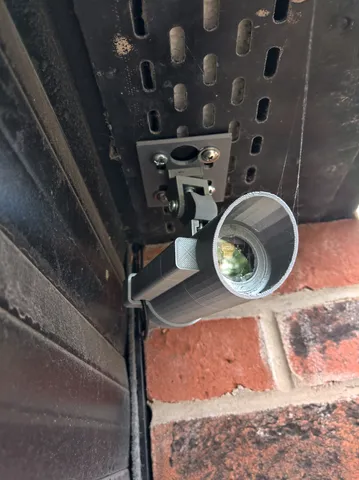
Raspberry Pi Zero W Security Camera
prusaprinters
This is a case for a Raspberry Pi Zero W and Camera Module, to make a self contained security camera.I have set it up with the Pi Noir module and motionEyeOS to make an infra-red capable motion-sensing security camera.MotionEyeOS: https://github.com/ccrisan/motioneyeos/wikiMotionEyeOS is based on Motion for Linux, and makes it easy to set up a motion sensing security camera.Other components needed:Sapphire watch glass (34mm dia). It needs to be sapphire if you want to use the Pi Noir to see in IR wavelengths. You will also need a separate IR floodlight if you are planning to use at night. Both can be found on eBay for a few pounds.Silicone adhesive. Use it to seal the watch glass to the front of the case, and optionally to seal the cap and wire exit if your camera is exposed.Some M5 & M6 bolts and nylock nuts to assemble the brackets. Use nylock in order to maintain the right level of friction in the brackets so the camera doesn't move.Right angle micro USB cable to power the PiThe case is designed to allow the Pi to be powered by a USB cable with a 90 degree right angle on the micro USB end, which exits through the slot on the side at the back of the case. The cap covers the rest of the slot leaving just a small hole for the cable to exit.Flash the motonEyeOS to your microSD card and fit it to the board before you start; it's easier, but you should still be able to fit it later if you need to.To assemble:Glue the watch glass to the front of the case using silicone.Connect the camera board to the Pi using the standard length cable.Join the Cam Holder Front Top & Bottom parts together, sandwiching the Pi Zero board between them at the end with the camera connector.Slide the assembly up the groves in the back of the Cam Module block.Carefully fold the camera ribbon cable under the Pi and back, and clip the camera board into the front of the cam module. The ribbon cable needs to be handled carefully, not folded tightly or kinked, but it will fit with relatively gentle bends in the cable.Connect the 90 degree power cable to the Pi.Slide the Pi, attached to the camera module down into the case, allowing the cable to trail back along the space to the side.Attach the two rear holders around the rear of the Pi, and finish inserting into the case, using the slots in the holder and the ridges inside the case to align the whole Pi camera unit within the case.Insert the microsd card if you haven't already, and fit the cap.Assemble the bracket pieces, fix the camera case to the bracket, and the base to your chosen location (the slots in the base plate match with the i-beam I wanted to attach it to; I don't know if these are standard spacing)Power it up and follow the motionEyeOS instructions to configure the camera to do whatever you want it to do - continual recording, timed, motion sensitive, stills or video etc.It probably isn't the most waterproof thing in the world, but it should be fine especially if the camera has some shelter, and you can always be liberal with the silicone. I've had no water inside mine which although sheltered, has no silicone other than for the glass.You could also add some silicone to keep the Pi board holders together too - I originally designed it for bolts but it didn't really work - the pins seem to keep it together well enough but some extra silicone wouldn't hurt.
With this file you will be able to print Raspberry Pi Zero W Security Camera with your 3D printer. Click on the button and save the file on your computer to work, edit or customize your design. You can also find more 3D designs for printers on Raspberry Pi Zero W Security Camera.
